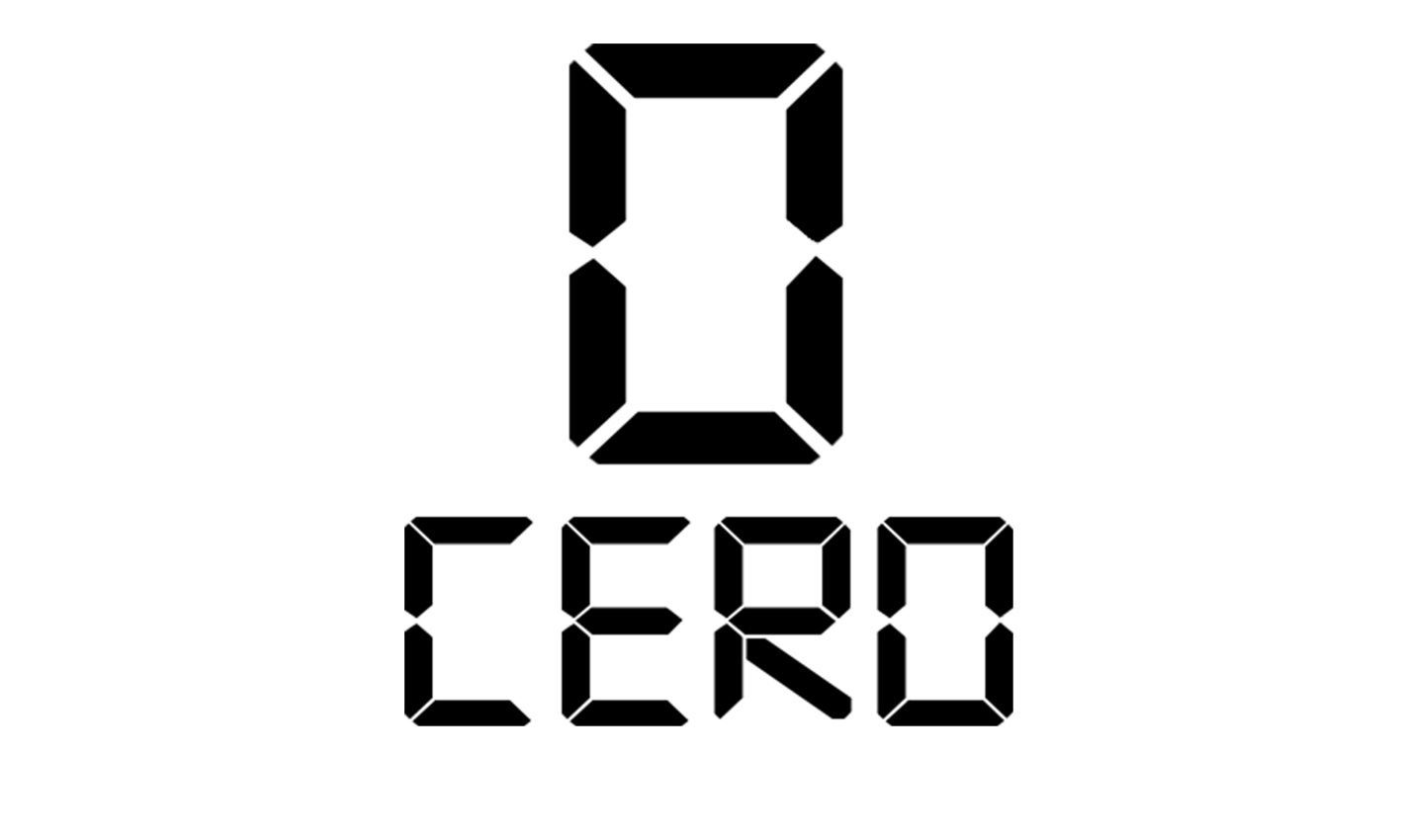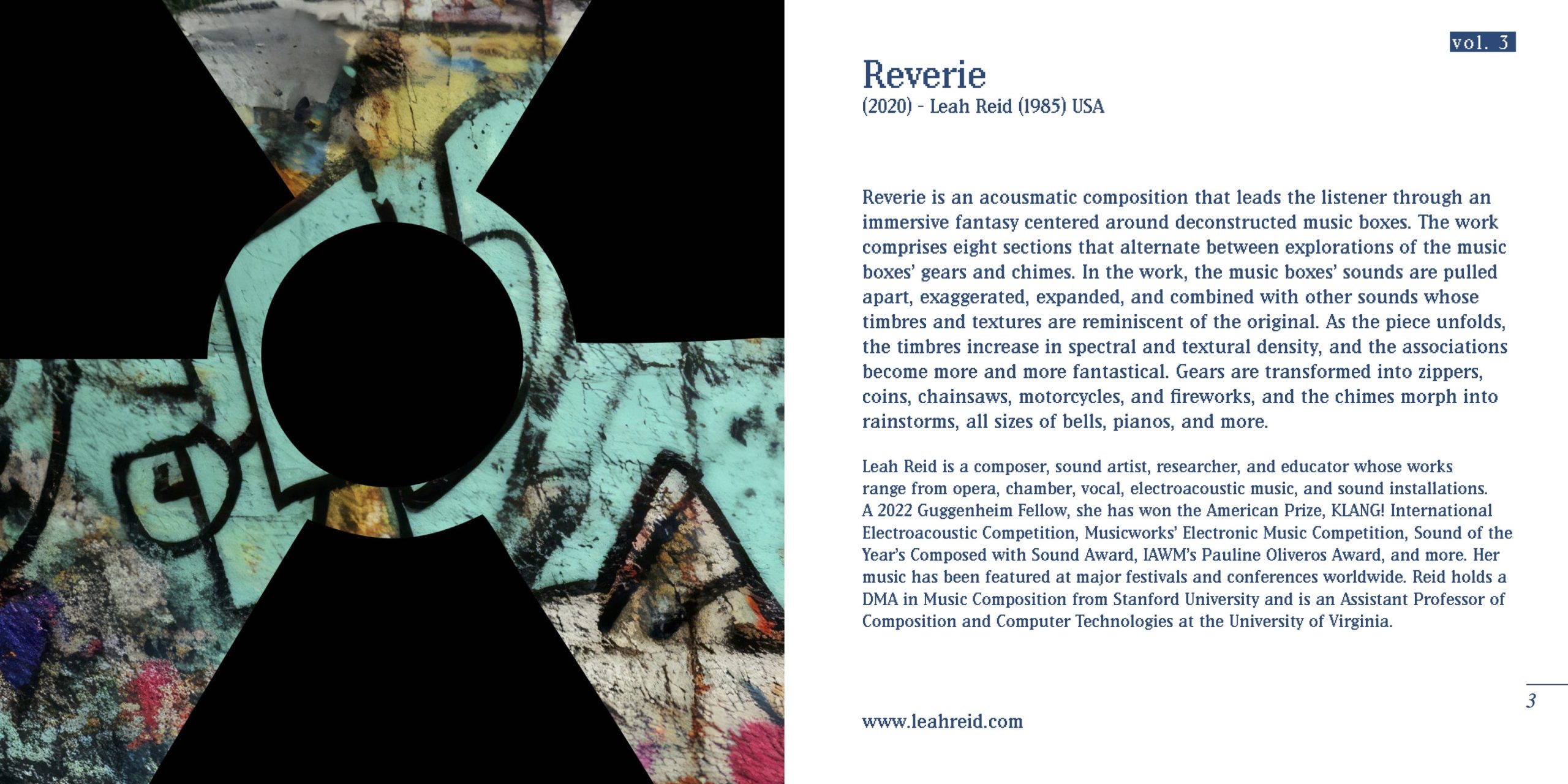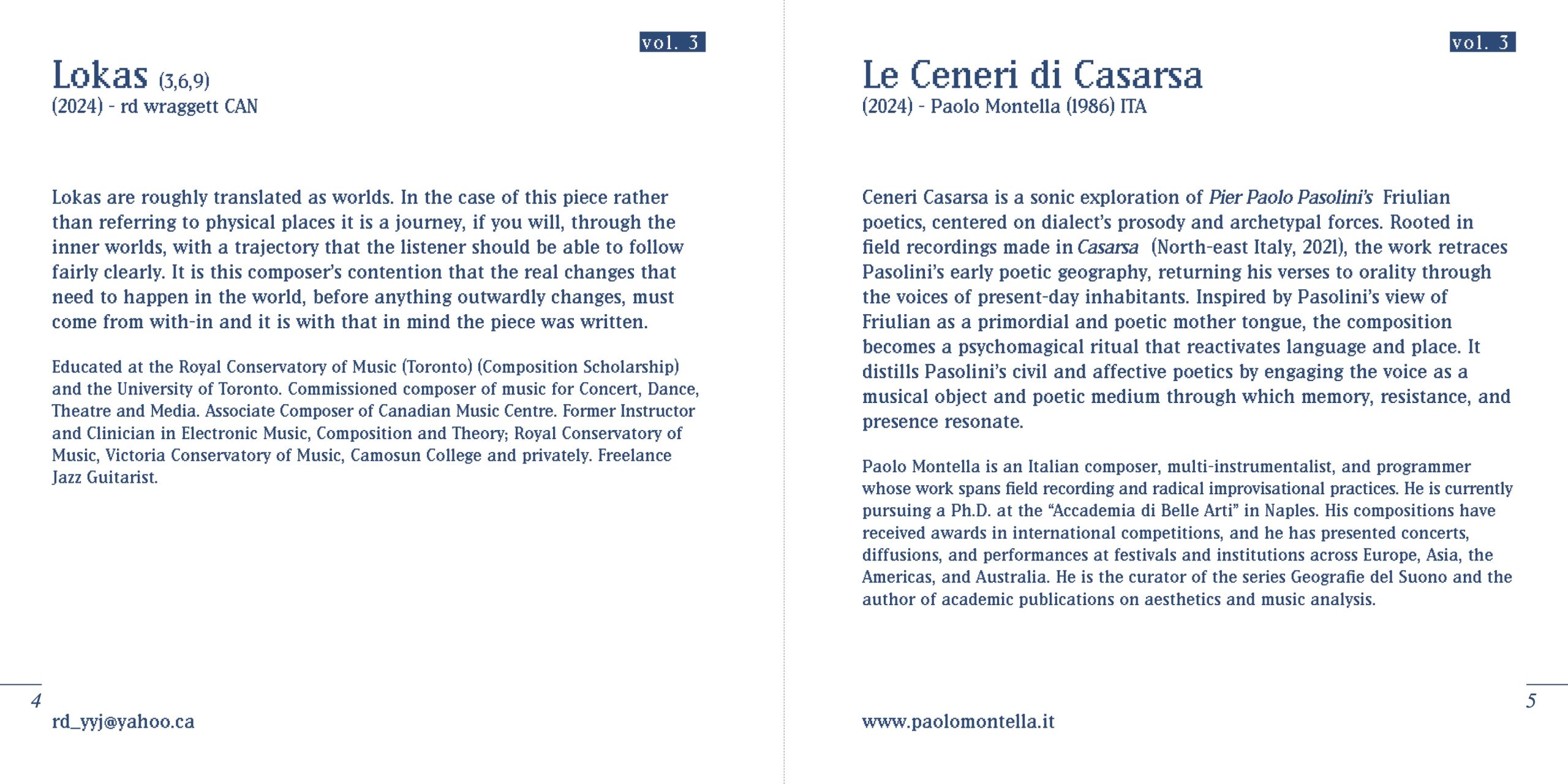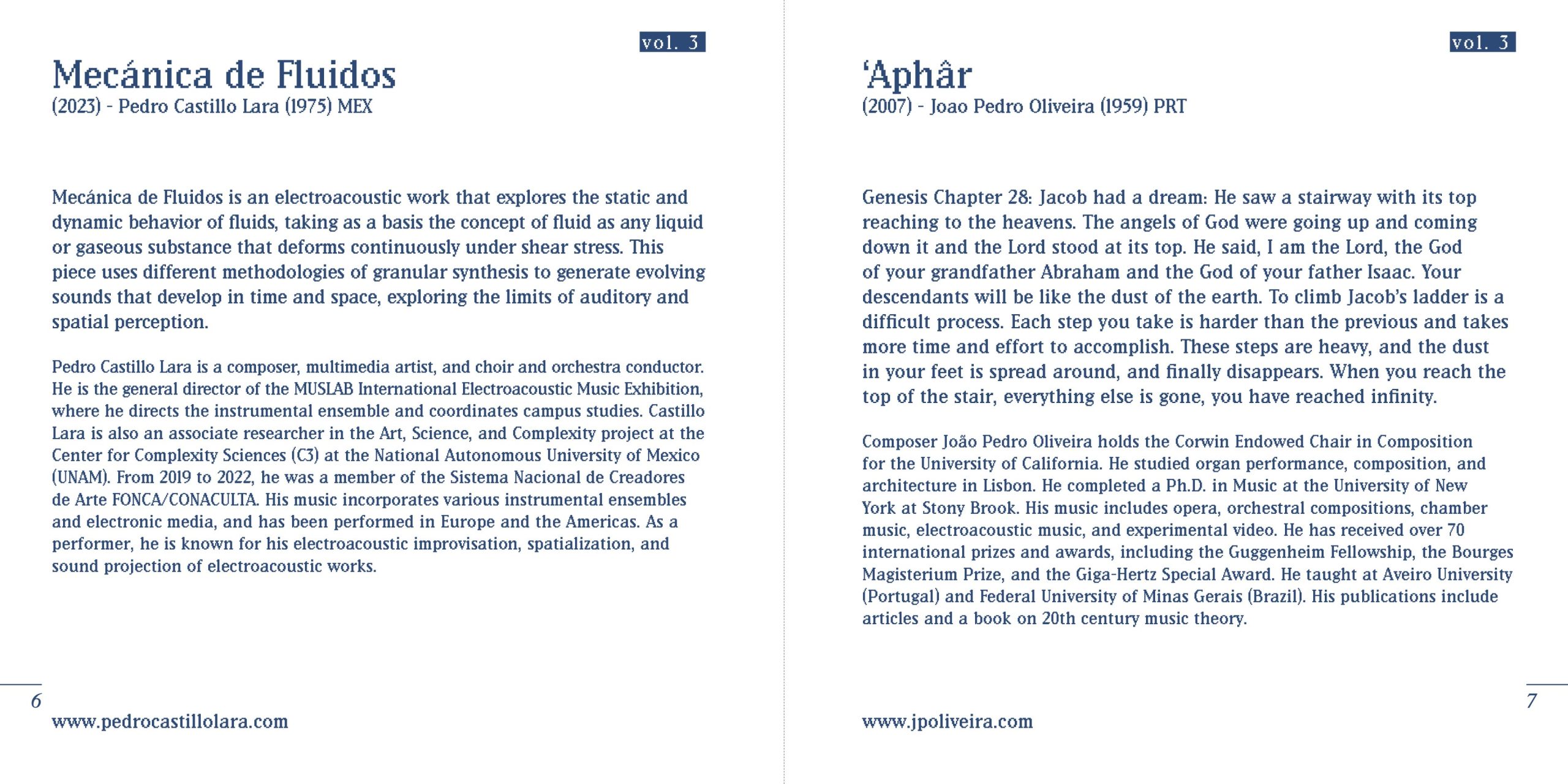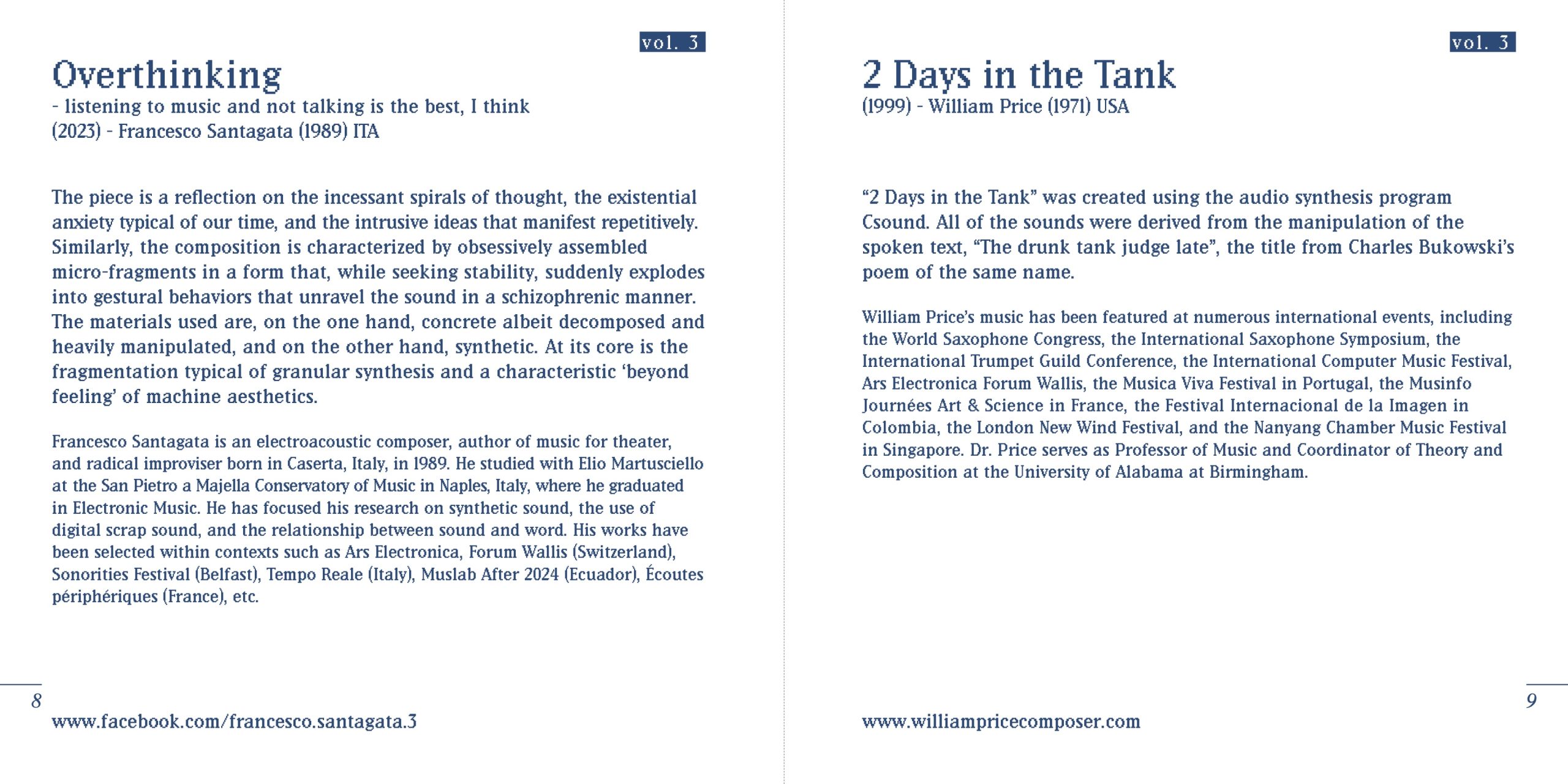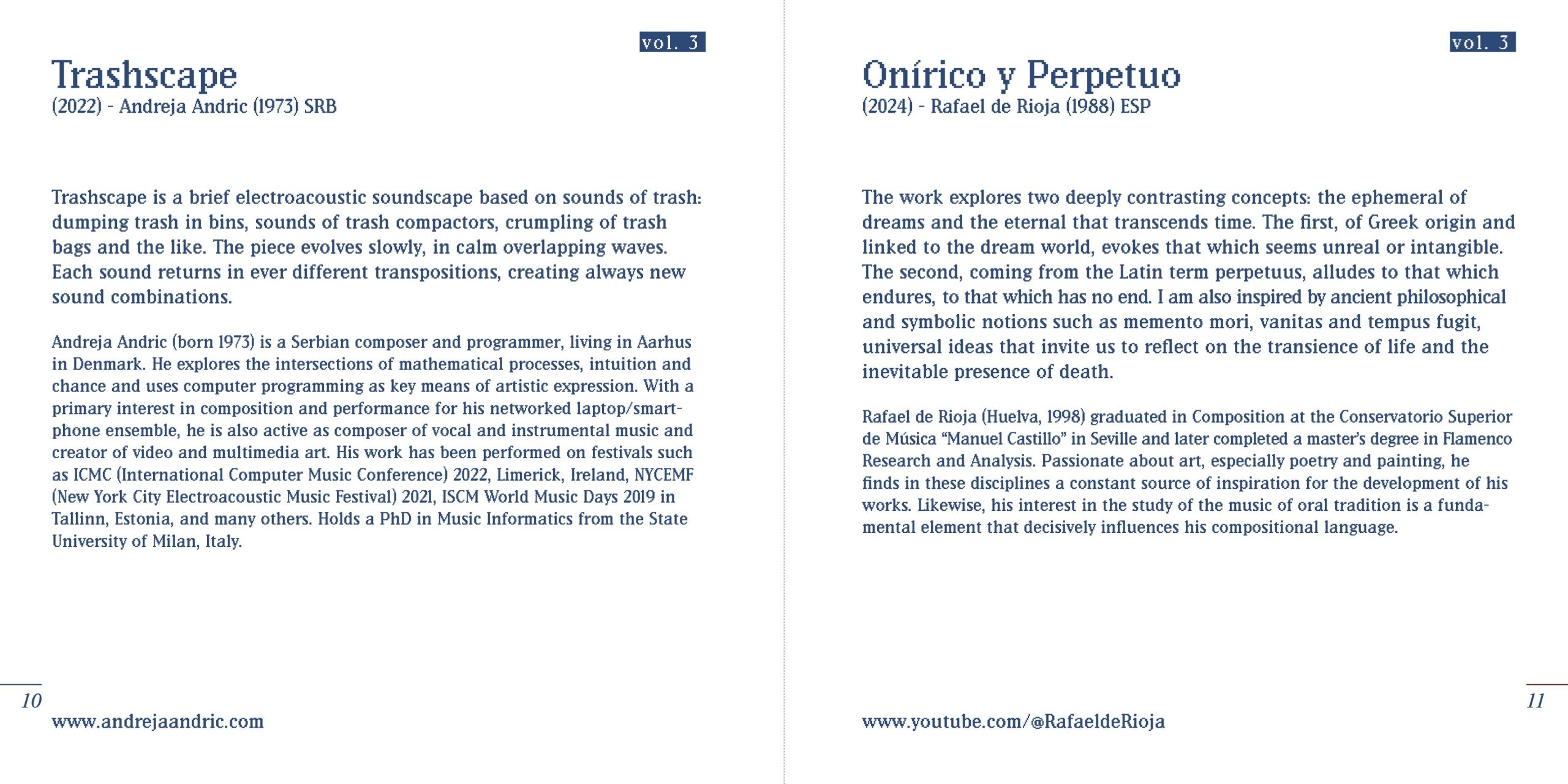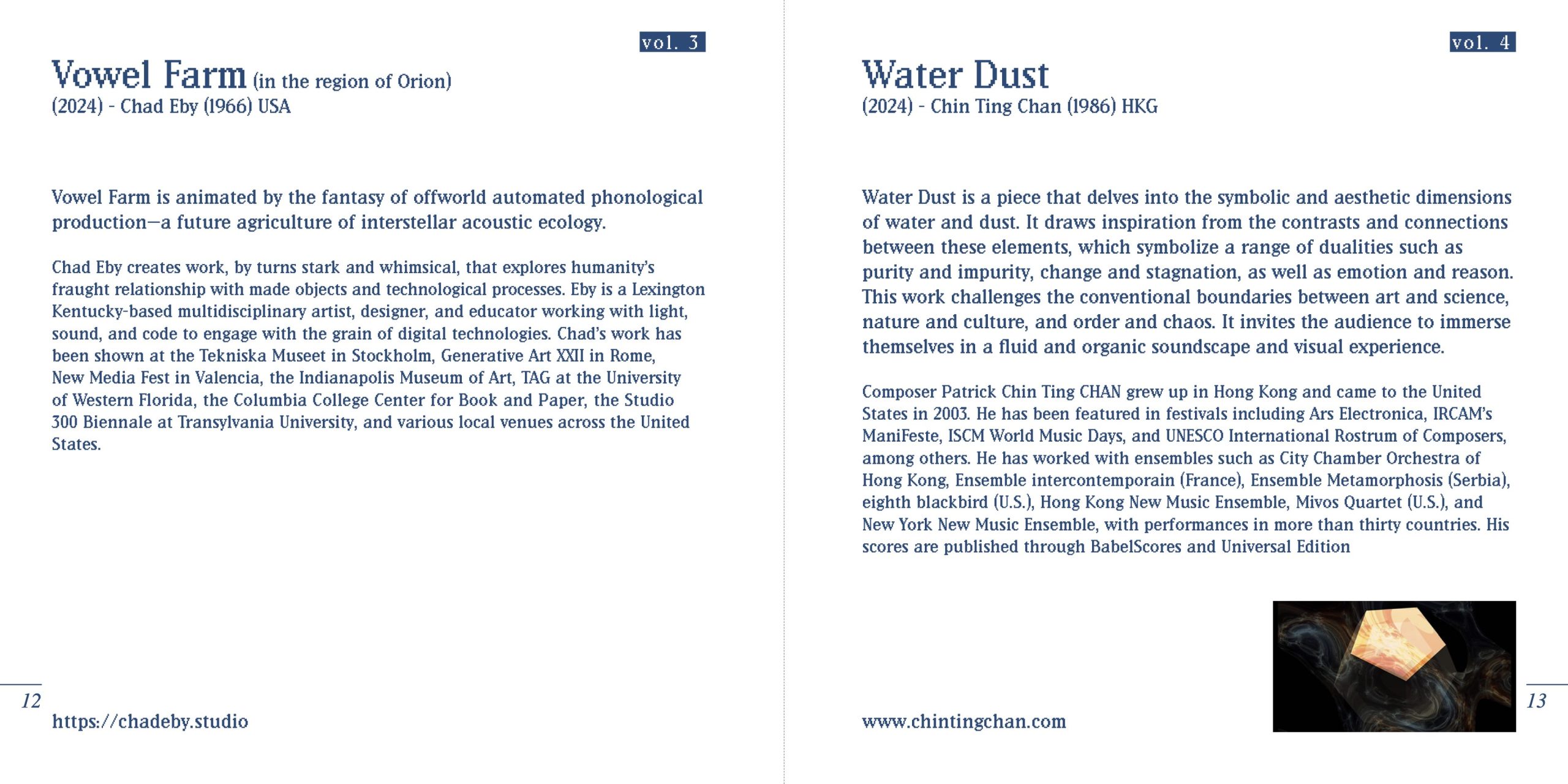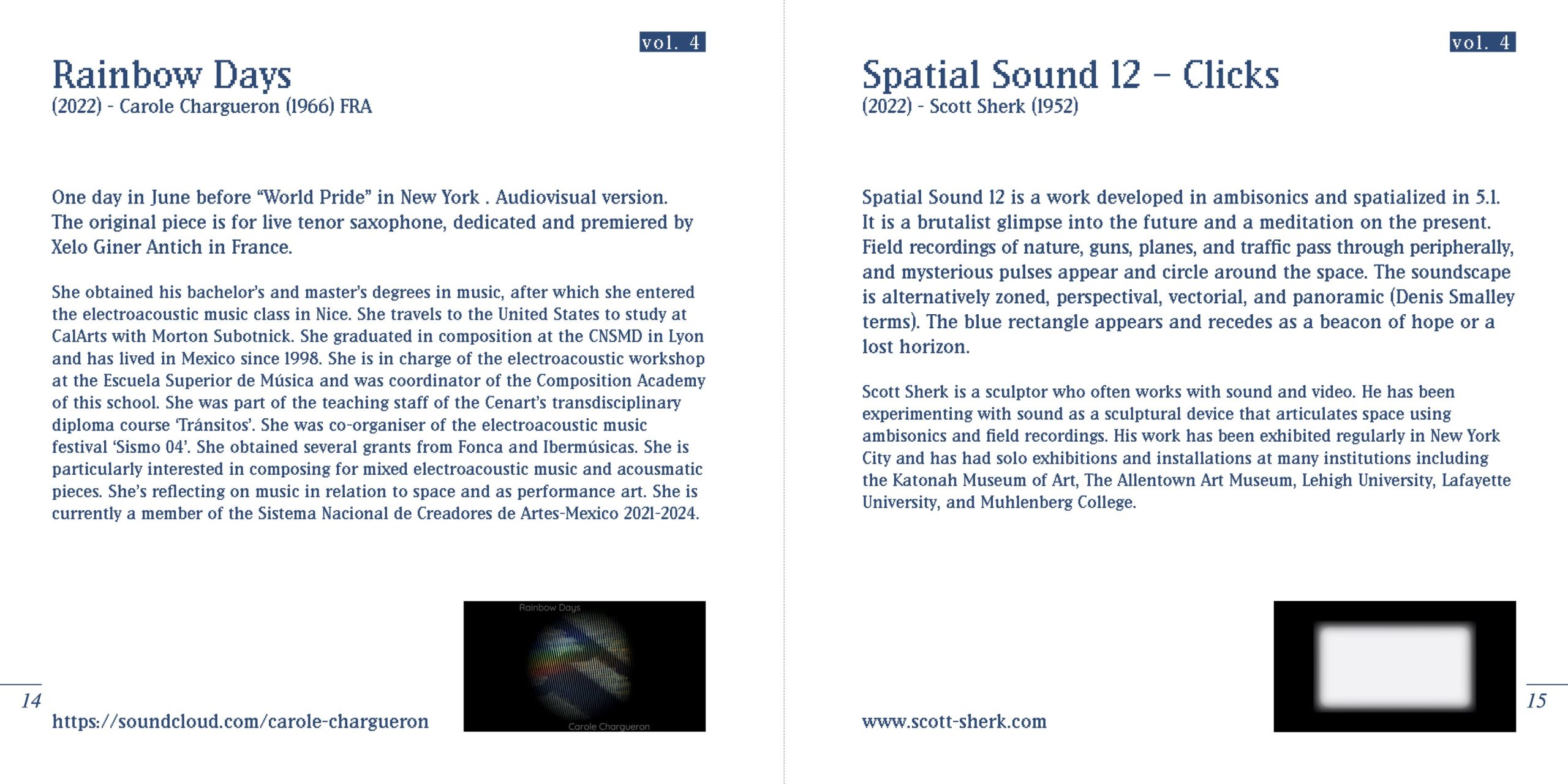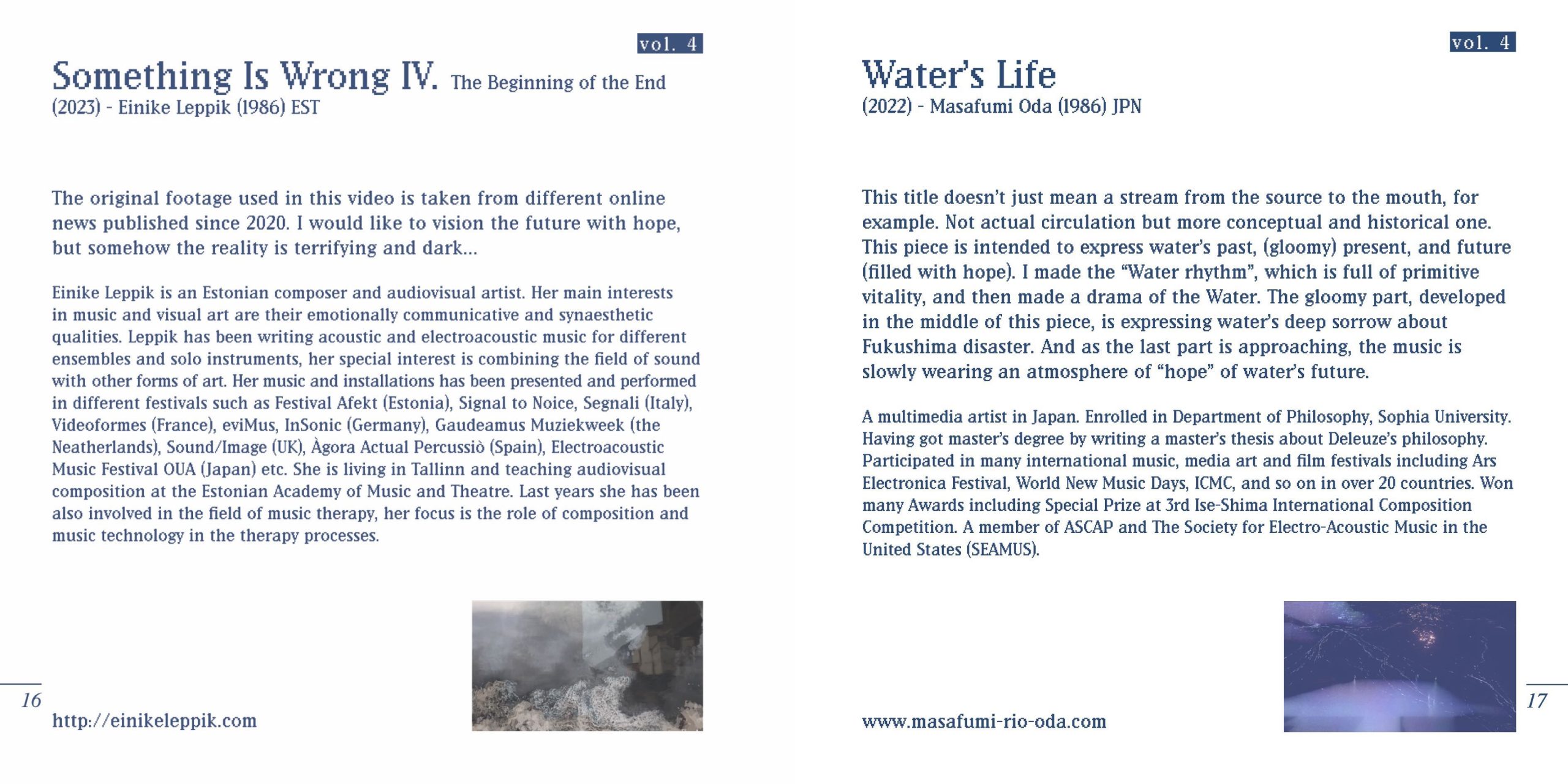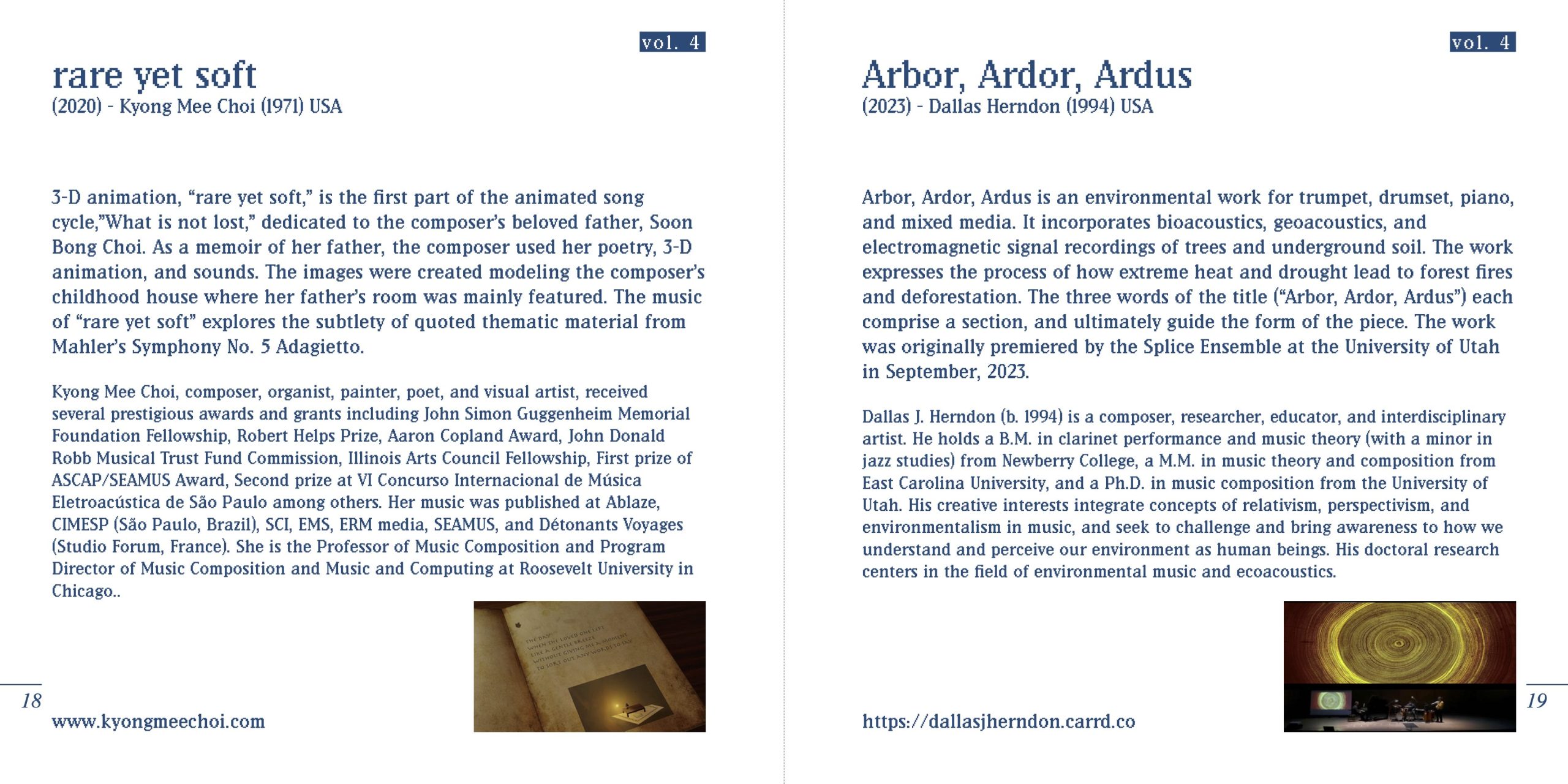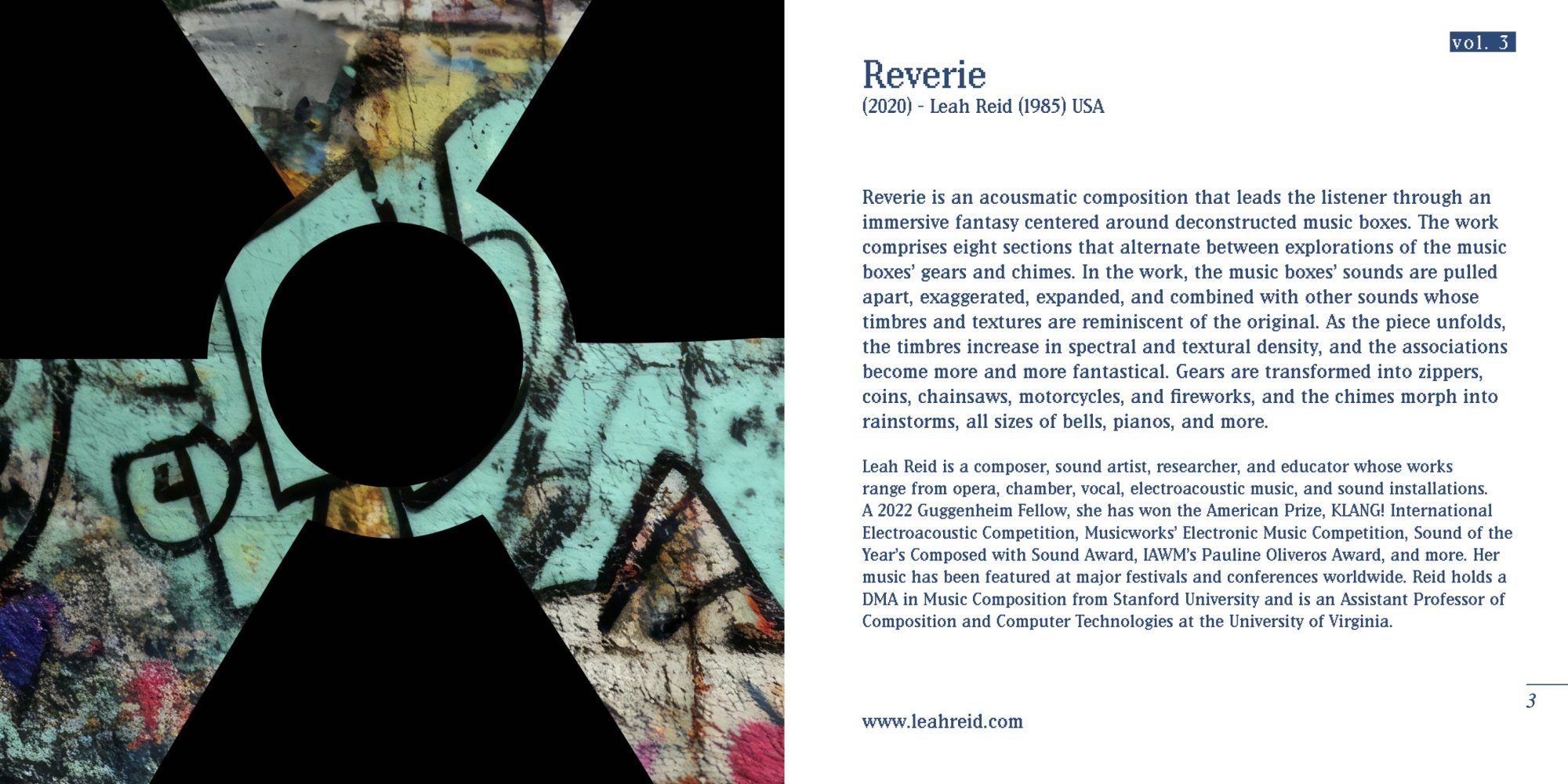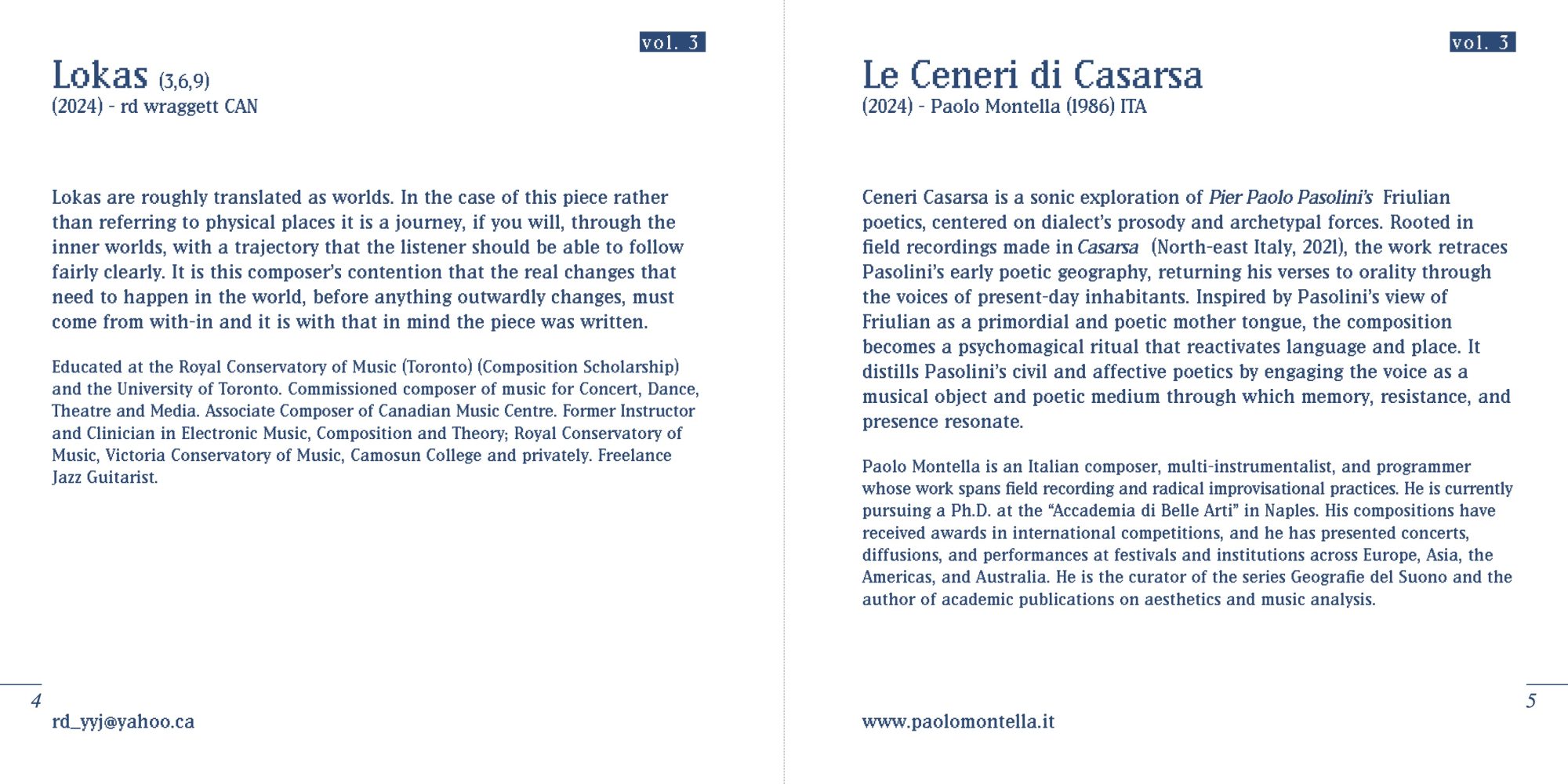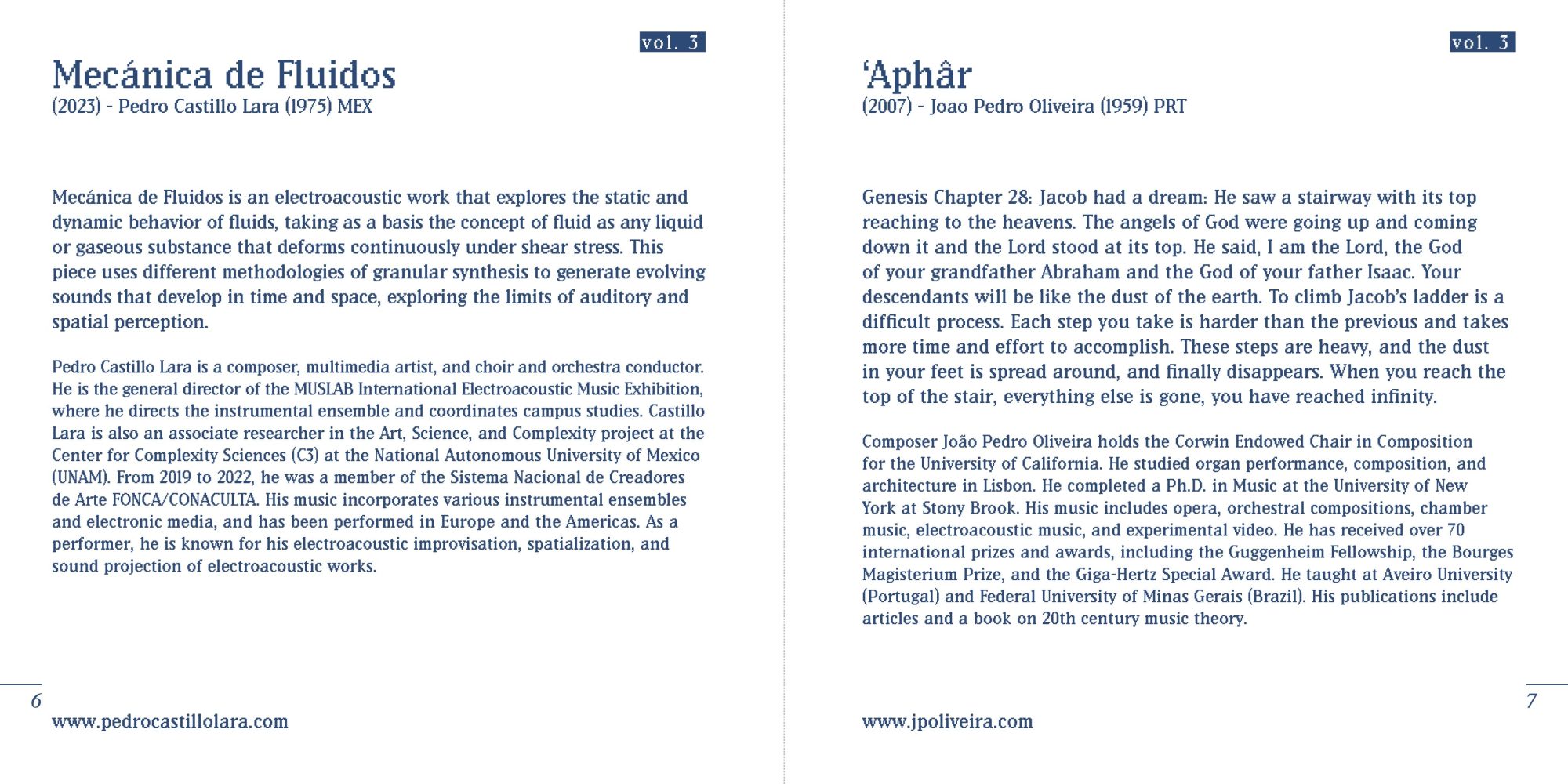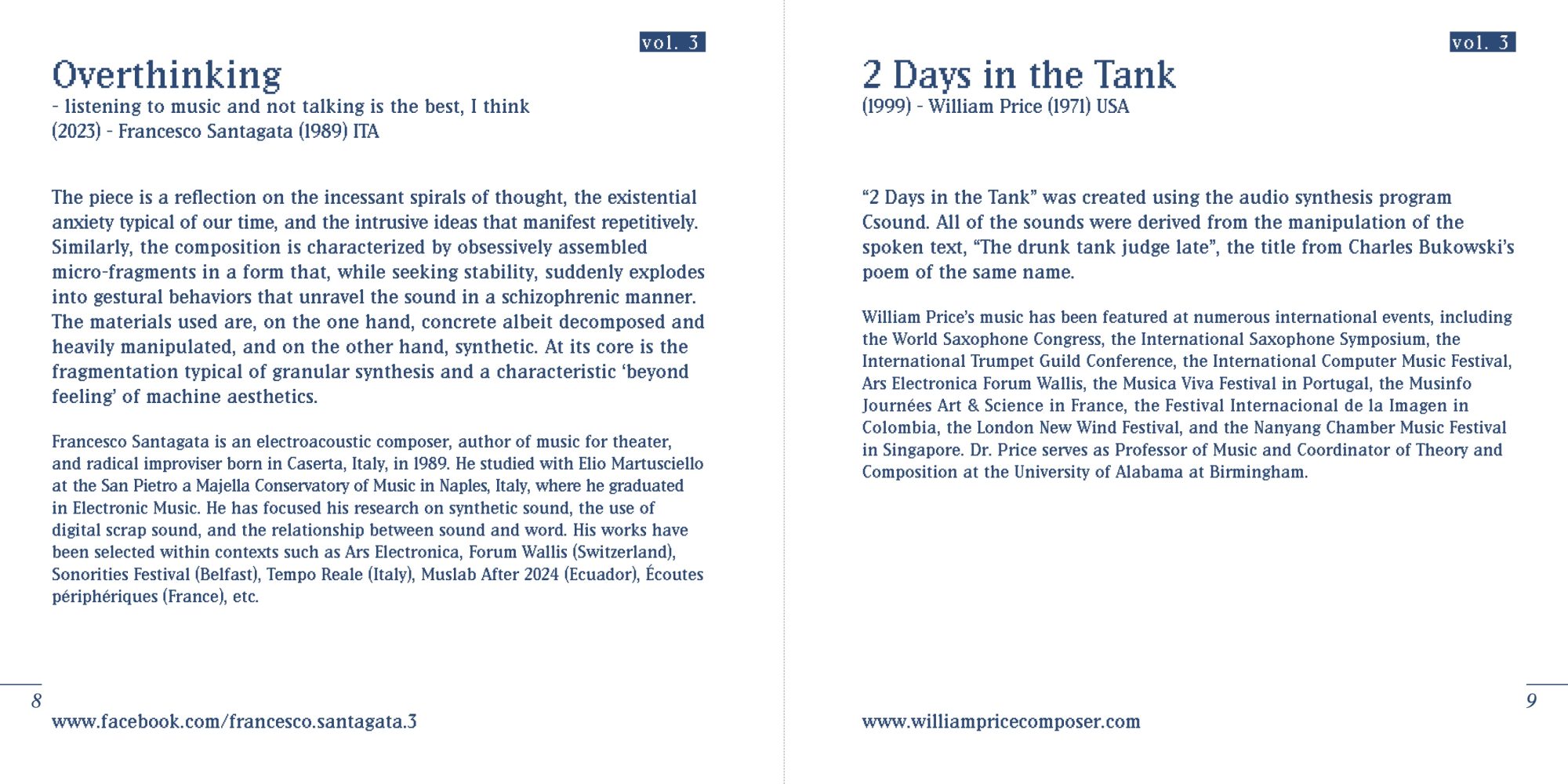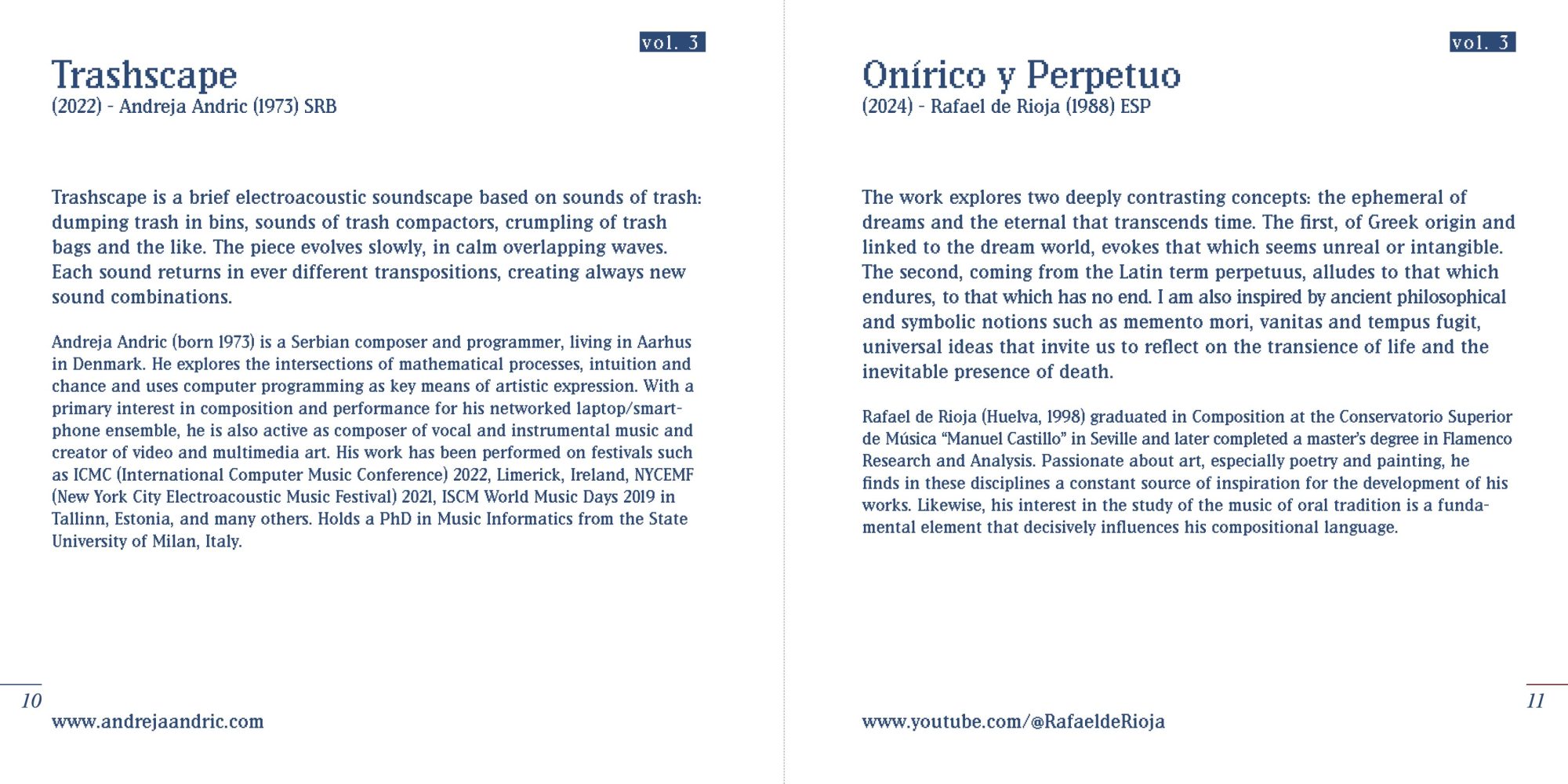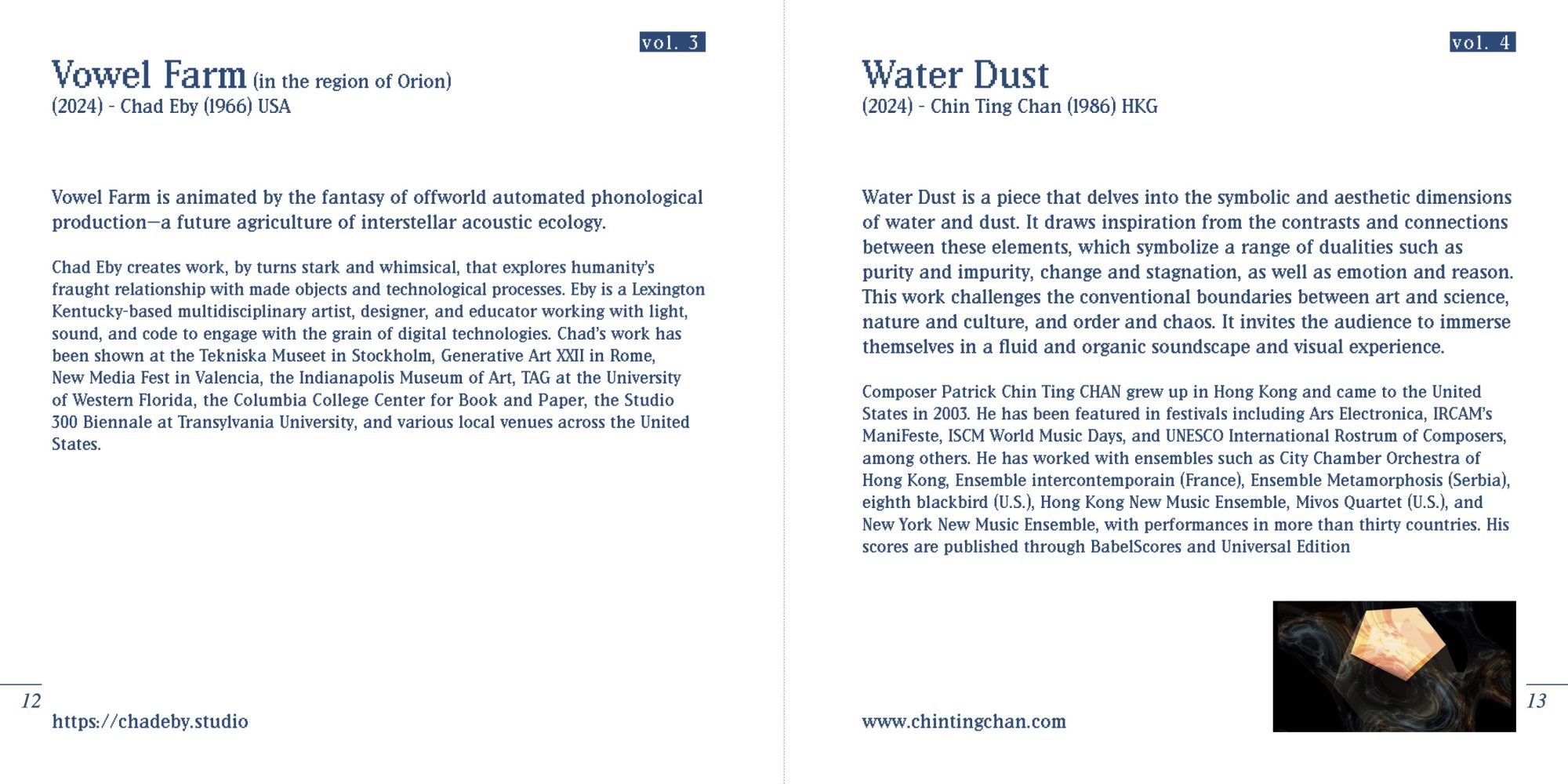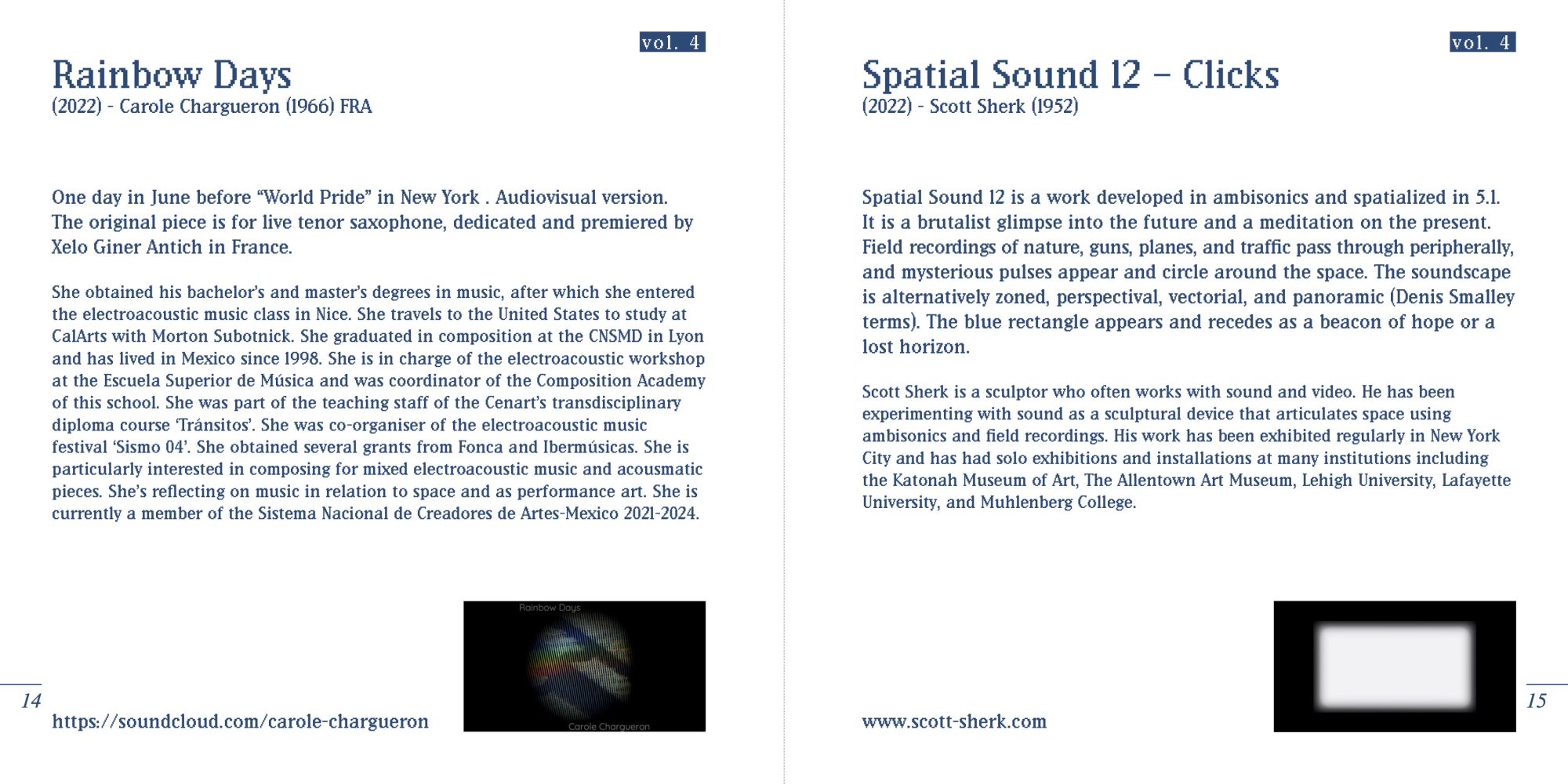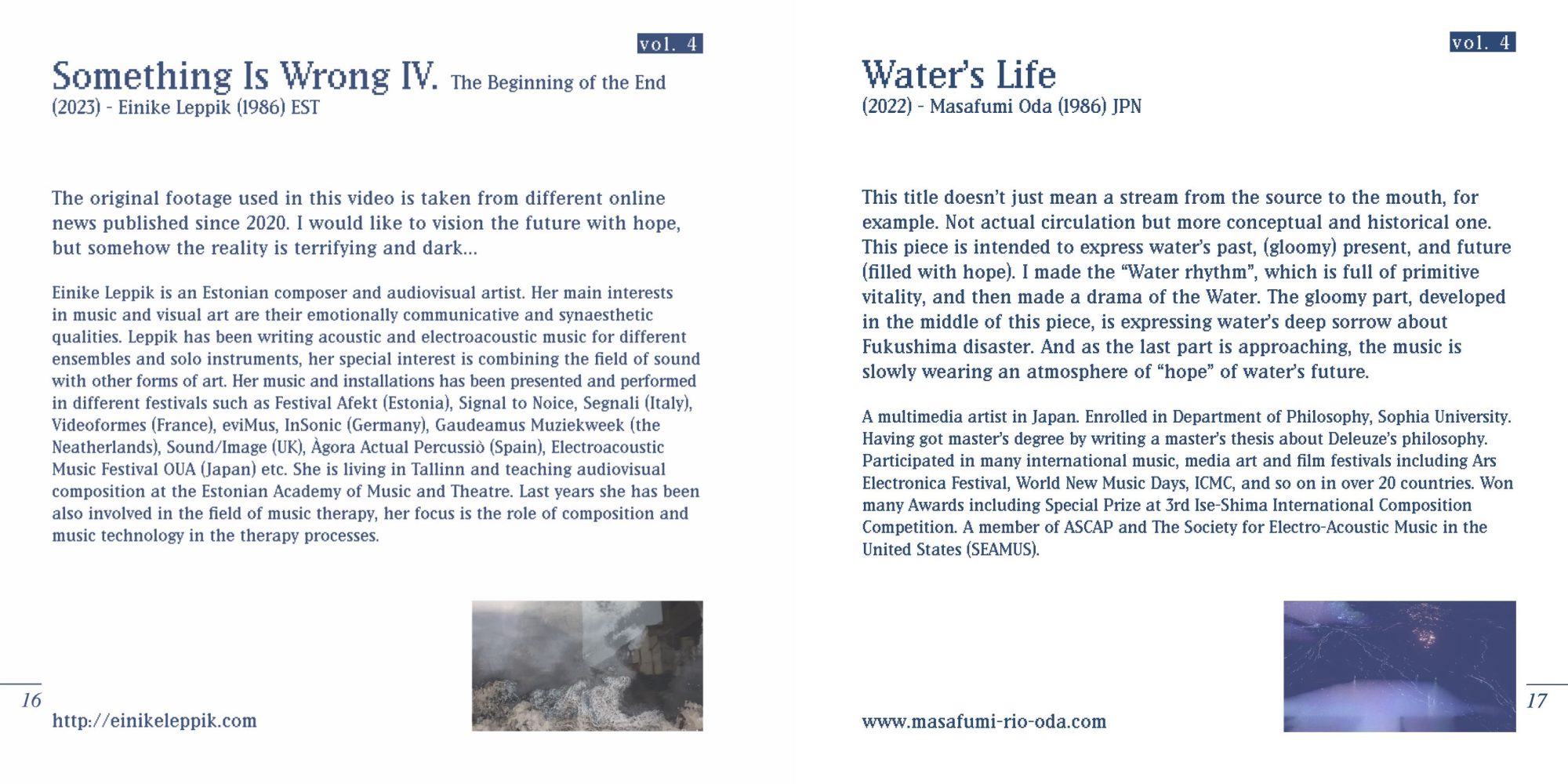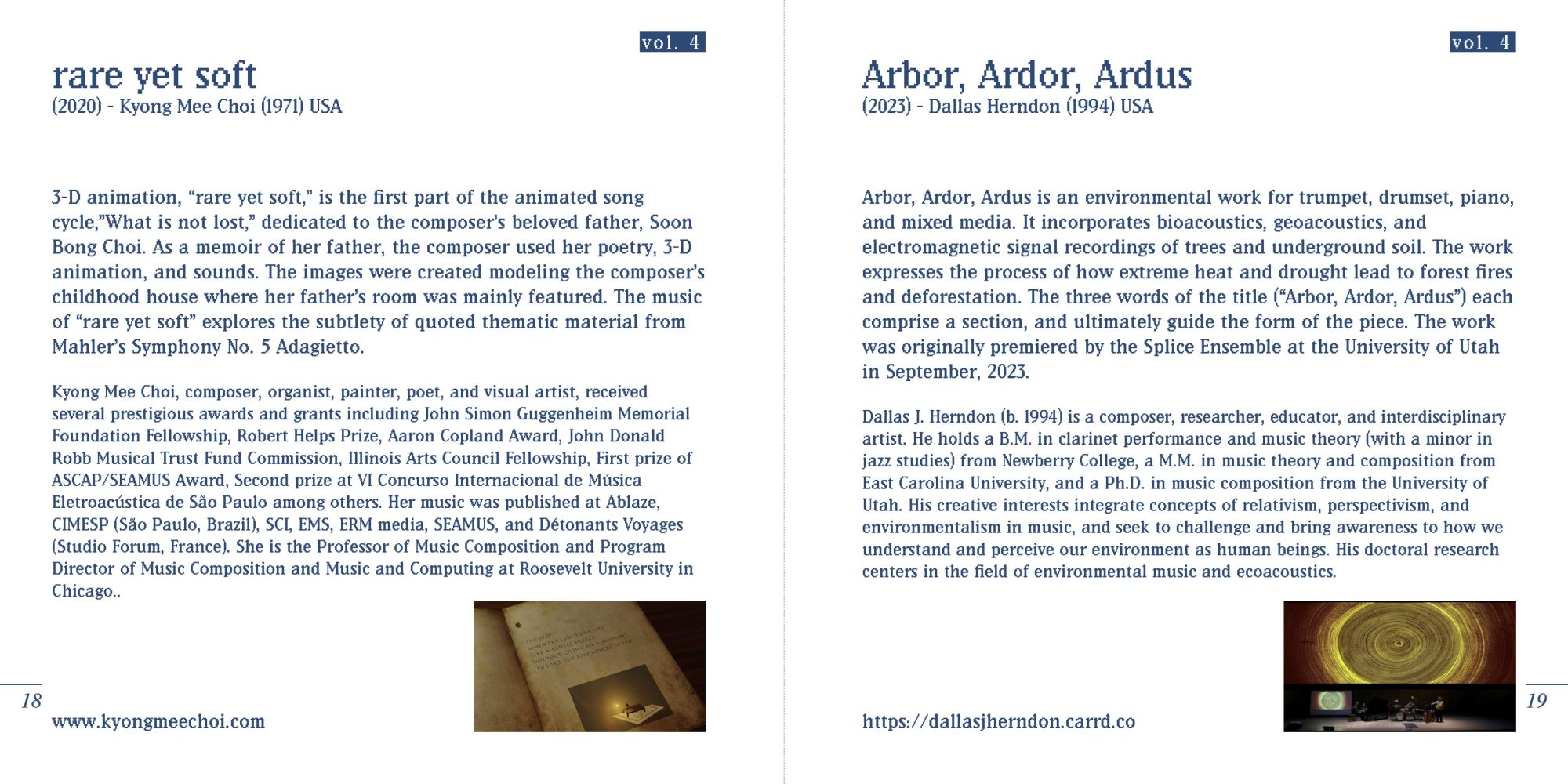Tracking
MUSLAB
-AFTER- Vol.3
1 Reverie – Leah Reid 10:30
2 Lokas (3,6,9) – rd wraggett 7:56
3 Le Ceneri di Casarsa – Paolo Montella 8:01
4 Mecánica de Fluidos – Pedro Castillo Lara 8:24
5 ‘Aphâr – João Pedro Oliveira 11:01
6 Overthinking – listening to music and not talking is the best, I think – Francesco Santagata 6:46
7 2 Days in the Tank – William Price 4:46
8 Trashscape – Andreja Andric 5:53
9 Onírico y Perpetuo – Rafael de Rioja 5:38
10 Vowel Farm (in the region of Orion) – Chad Eby 5:06
Total 74:01
MUSLAB
-AFTER- Vol.4 DVD
1 Water Dust – Chin Ting Chan 9:02
2 Rainbow Days – Carole Chargueron 9:30
3 Spatial Sound 12 – Clicks – Scott Sherk 4:44
4 Something Is Wrong IV. The Beginning of the End. – Einike Leppik 10:05
5 Water’s Life – Masafumi Oda 9:58
6 rare yet soft – Kyong Mee Choi 7:12
7 Arbor, Ardor, Ardus – Dallas Herndon 6:35
Total 57:06
Compositores / Descripciones de las Obras
Reverie (2020) – Leah Reid (1985) USA
Reverie is an acousmatic composition that leads the listener through an immersive fantasy centered around deconstructed music boxes. The work comprises eight sections that alternate between explorations of the music boxes’ gears and chimes. In the work, the music boxes’ sounds are pulled apart, exaggerated, expanded, and combined with other sounds whose timbres and textures are reminiscent of the original. As the piece unfolds, the timbres increase in spectral and textural density, and the associations become more and more fantastical. Gears are transformed into zippers, coins, chainsaws, motorcycles, and fireworks, and the chimes morph into rainstorms, all sizes of bells, pianos, and more.
Leah Reid is a composer, sound artist, researcher, and educator whose works range from opera, chamber, vocal, electroacoustic music, and sound installations. A 2022 Guggenheim Fellow, she has won the American Prize, KLANG! International Electroacoustic Competition, Musicworks’ Electronic Music Competition, Sound of the Year’s Composed with Sound Award, IAWM’s Pauline Oliveros Award, and more. Her music has been featured at major festivals and conferences worldwide. Reid holds a DMA in Music Composition from Stanford University and is an Assistant Professor of Composition and Computer Technologies at the University of Virginia. www.leahreid.com
Lokas (3,6,9) (2024) – rd wraggett CAN
Lokas are roughly translated as worlds. In the case of this piece rather than referring to physical places it is a journey, if you will, through the inner worlds, with a trajectory that the listener should be able to follow fairly clearly. It is this composer’s contention that the real changes that need to happen in the world, before anything outwardly changes, must come from with-in and it is with that in mind the piece was written.
Educated at the Royal Conservatory of Music (Toronto) (Composition Scholarship) and the University of Toronto. Commissioned composer of music for Concert, Dance, Theatre and Media. Associate Composer of Canadian Music Centre. Former Instructor and Clinician in Electronic Music, Composition and Theory; Royal Conservatory of Music, Victoria Conservatory of Music, Camosun College and privately. Freelance Jazz Guitarist. rd_yyj@yahoo.ca
Le Ceneri di Casarsa (2024) – Paolo Montella (1986) ITA
Ceneri Casarsa is a sonic exploration of Pier Paolo Pasolini’s Friulian poetics, centered on dialect’s prosody and archetypal forces. Rooted in field recordings made in Casarsa (North-east Italy, 2021), the work retraces Pasolini’s early poetic geography, returning his verses to orality through the voices of present-day inhabitants. Inspired by Pasolini’s view of Friulian as a primordial and poetic mother tongue, the composition becomes a psychomagical ritual that reactivates language and place. It distills Pasolini’s civil and affective poetics by engaging the voice as a musical object and poetic medium through which memory, resistance, and presence resonate.
Paolo Montella is an Italian composer, multi-instrumentalist, and programmer whose work spans field recording and radical improvisational practices. He is currently pursuing a Ph.D. at the “Accademia di Belle Arti” in Naples. His compositions have received awards in international competitions, and he has presented concerts, diffusions, and performances at festivals and institutions across Europe, Asia, the Americas, and Australia. He is the curator of the series Geografie del Suono and the author of academic publications on aesthetics and music analysis. www.paolomontella.it
Mecánica de Fluidos (2023) – Pedro Castillo Lara (1975) MEX
Mecánica de Fluidos is an electroacoustic work that explores the static and dynamic behavior of fluids, taking as a basis the concept of fluid as any liquid or gaseous substance that deforms continuously under shear stress. This piece uses different methodologies of granular synthesis to generate evolving sounds that develop in time and space, exploring the limits of auditory and spatial perception.
Pedro Castillo Lara is a composer, multimedia artist, and choir and orchestra conductor. He is the general director of the MUSLAB International Electroacoustic Music Exhibition, where he directs the instrumental ensemble and coordinates campus studies. Castillo Lara is also an associate researcher in the Art, Science, and Complexity project at the Center for Complexity Sciences (C3) at the National Autonomous University of Mexico (UNAM). From 2019 to 2022, he was a member of the Sistema Nacional de Creadores de Arte FONCA/CONACULTA. His music incorporates various instrumental ensembles and electronic media, and has been performed in Europe and the Americas. As a performer, he is known for his electroacoustic improvisation, spatialization, and sound projection of electroacoustic works. www.pedrocastillolara.com
‘Aphâr (2007) – Joao Pedro Oliveira (1959) PRT
Genesis Chapter 28: Jacob had a dream: He saw a stairway with its top reaching to the heavens. The angels of God were going up and coming down it and the Lord stood at its top. He said, I am the Lord, the God of your grandfather Abraham and the God of your father Isaac. Your descendants will be like the dust of the earth. To climb Jacob’s ladder is a difficult process. Each step you take is harder than the previous and takes more time and effort to accomplish. These steps are heavy, and the dust in your feet is spread around, and finally disappears. When you reach the top of the stair, everything else is gone, you have reached infinity.
Composer João Pedro Oliveira holds the Corwin Endowed Chair in Composition for the University of California. He studied organ performance, composition, and architecture in Lisbon. He completed a Ph.D. in Music at the University of New York at Stony Brook. His music includes opera, orchestral compositions, chamber music, electroacoustic music, and experimental video. He has received over 70 international prizes and awards, including the Guggenheim Fellowship, the Bourges Magisterium Prize, and the Giga-Hertz Special Award. He taught at Aveiro University (Portugal) and Federal University of Minas Gerais (Brazil). His publications include articles and a book on 20th century music theory. www.jpoliveira.com
Overthinking – listening to music and not talking is the best, I think (2023) – Francesco Santagata (1989) ITA
The piece is a reflection on the incessant spirals of thought, the existential anxiety typical of our time, and the intrusive ideas that manifest repetitively. Similarly, the composition is characterized by obsessively assembled micro-fragments in a form that, while seeking stability, suddenly explodes into gestural behaviors that unravel the sound in a schizophrenic manner. The materials used are, on the one hand, concrete albeit decomposed and heavily manipulated, and on the other hand, synthetic. At its core is the fragmentation typical of granular synthesis and a characteristic ‘beyond feeling’ of machine aesthetics.
Francesco Santagata is an electroacoustic composer, author of music for theater, and radical improviser born in Caserta, Italy, in 1989. He studied with Elio Martusciello at the San Pietro a Majella Conservatory of Music in Naples, Italy, where he graduated in Electronic Music. He has focused his research on synthetic sound, the use of digital scrap sound, and the relationship between sound and word. His works have been selected within contexts such as Ars Electronica, Forum Wallis (Switzerland), Sonorities Festival (Belfast), Tempo Reale (Italy), Muslab After 2024 (Ecuador), Écoutes périphériques (France), etc. www.facebook.com/francesco.santagata.3
2 Days in the Tank (1999) – William Price (1971) USA
“2 Days in the Tank” was created using the audio synthesis program Csound. All of the sounds were derived from the manipulation of the spoken text, “The drunk tank judge late”, the title from Charles Bukowski’s poem of the same name.
William Price’s music has been featured at numerous international events, including the World Saxophone Congress, the International Saxophone Symposium, the International Trumpet Guild Conference, the International Computer Music Festival, Ars Electronica Forum Wallis, the Musica Viva Festival in Portugal, the Musinfo Journées Art & Science in France, the Festival Internacional de la Imagen in Colombia, the London New Wind Festival, and the Nanyang Chamber Music Festival in Singapore. Dr. Price serves as Professor of Music and Coordinator of Theory and Composition at the University of Alabama at Birmingham. www.williampricecomposer.com
Trashscape (2022) – Andreja Andric (1973) SRB
Trashscape is a brief electroacoustic soundscape based on sounds of trash: dumping trash in bins, sounds of trash compactors, crumpling of trash bags and the like. The piece evolves slowly, in calm overlapping waves. Each sound returns in ever different transpositions, creating always new sound combinations.
Andreja Andric (born 1973) is a Serbian composer and programmer, living in Aarhus in Denmark. He explores the intersections of mathematical processes, intuition and chance and uses computer programming as key means of artistic expression. With a primary interest in composition and performance for his networked laptop/smartphone ensemble, he is also active as composer of vocal and instrumental music and creator of video and multimedia art. His work has been performed on festivals such as ICMC (International Computer Music Conference) 2022, Limerick, Ireland, NYCEMF (New York City Electroacoustic Music Festival) 2021, ISCM World Music Days 2019 in Tallinn, Estonia, and many others. Holds a PhD in Music Informatics from the State University of Milan, Italy. www.andrejaandric.com
Onírico y Perpetuo (2024) – Rafael de Rioja (1998) ESP
The work explores two deeply contrasting concepts: the ephemeral of dreams and the eternal that transcends time. The first, of Greek origin and linked to the dream world, evokes that which seems unreal or intangible. The second, coming from the Latin term perpetuus, alludes to that which endures, to that which has no end. I am also inspired by ancient philosophical and symbolic notions such as memento mori, vanitas and tempus fugit, universal ideas that invite us to reflect on the transience of life and the inevitable presence of death.
Rafael de Rioja (Huelva, 1998) graduated in Composition at the Conservatorio Superior de Música “Manuel Castillo” in Seville and later completed a master’s degree in Flamenco Research and Analysis. Passionate about art, especially poetry and painting, he finds in these disciplines a constant source of inspiration for the development of his works. Likewise, his interest in the study of the music of oral tradition is a fundamental element that decisively influences his compositional language. www.youtube.com/@RafaeldeRioja
Vowel Farm (in the region of Orion) (2024) – Chad Eby (1966) USA
Vowel Farm is animated by the fantasy of offworld automated phonological production—a future agriculture of interstellar acoustic ecology.
Chad Eby creates work, by turns stark and whimsical, that explores humanity’s fraught relationship with made objects and technological processes. Eby is a Lexington Kentucky-based multidisciplinary artist, designer, and educator working with light, sound, and code to engage with the grain of digital technologies. Chad’s work has been shown at the Tekniska Museet in Stockholm, Generative Art XXII in Rome, New Media Fest in Valencia, the Indianapolis Museum of Art, TAG at the University of Western Florida, the Columbia College Center for Book and Paper, the Studio 300 Biennale at Transylvania University, and various local venues across the United States. https://chadeby.studio
MUSLAB
-AFTER- Vol. 4 DVD
Water Dust (2024) – Chin Ting Chan (1986) HKG
Water Dust is a piece that delves into the symbolic and aesthetic dimensions of water and dust. It draws inspiration from the contrasts and connections between these elements, which symbolize a range of dualities such as purity and impurity, change and stagnation, as well as emotion and reason. This work challenges the conventional boundaries between art and science, nature and culture, and order and chaos. It invites the audience to immerse themselves in a fluid and organic soundscape and visual experience.
Composer Patrick Chin Ting CHAN grew up in Hong Kong and came to the United States in 2003. He has been featured in festivals including Ars Electronica, IRCAM’s ManiFeste, ISCM World Music Days, and UNESCO International Rostrum of Composers, among others. He has worked with ensembles such as City Chamber Orchestra of Hong Kong, Ensemble intercontemporain (France), Ensemble Metamorphosis (Serbia), eighth blackbird (U.S.), Hong Kong New Music Ensemble, Mivos Quartet (U.S.), and New York New Music Ensemble, with performances in more than thirty countries. His scores are published through BabelScores and Universal Edition. www.chintingchan.com
Rainbow Days (2022) – Carole Chargueron (1966) FRA
One day in June before “World Pride” in New York . Audiovisual version.
The original piece is for live tenor saxophone, dedicated and premiered by Xelo Giner Antich in France.
She obtained his bachelor’s and master’s degrees in music, after which she entered the electroacoustic music class in Nice. She travels to the United States to study at CalArts with Morton Subotnick. She graduated in composition at the CNSMD in Lyon and has lived in Mexico since 1998. She is in charge of the electroacoustic workshop at the Escuela Superior de Música and was coordinator of the Composition Academy of this school. She was part of the teaching staff of the Cenart’s transdisciplinary diploma course ‘Tránsitos’. She was co-organiser of the electroacoustic music festival ‘Sismo 04’. She obtained several grants from Fonca and Ibermúsicas. She is particularly interested in composing for mixed electroacoustic music and acousmatic pieces. She’s reflecting on music in relation to space and as performance art. She is currently a member of the Sistema Nacional de Creadores de Artes-Mexico 2021-2024. https://soundcloud.com/carole-chargueron
Spatial Sound 12 – Clicks (2022) – Scott Sherk (1952)
Spatial Sound 12 is a work developed in ambisonics and spatialized in 5.1. It is a brutalist glimpse into the future and a meditation on the present. Field recordings of nature, guns, planes, and traffic pass through peripherally, and mysterious pulses appear and circle around the space. The soundscape is alternatively zoned, perspectival, vectorial, and panoramic (Denis Smalley terms). The blue rectangle appears and recedes as a beacon of hope or a lost horizon.
Scott Sherk is a sculptor who often works with sound and video. He has been experimenting with sound as a sculptural device that articulates space using ambisonics and field recordings. His work has been exhibited regularly in New York City and has had solo exhibitions and installations at many institutions including the Katonah Museum of Art, The Allentown Art Museum, Lehigh University, Lafayette University, and Muhlenberg College. www.scott-sherk.com
Something Is Wrong IV. The Beginning of the End (2023) – Einike Leppik (1986) EST
The original footage used in this video is taken from different online news published since 2020. I would like to vision the future with hope, but somehow the reality is terrifying and dark…
Einike Leppik is an Estonian composer and audiovisual artist. Her main interests in music and visual art are their emotionally communicative and synaesthetic qualities. Leppik has been writing acoustic and electroacoustic music for different ensembles and solo instruments, her special interest is combining the field of sound with other forms of art. Her music and installations has been presented and performed in different festivals such as Festival Afekt (Estonia), Signal to Noice, Segnali (Italy), Videoformes (France), eviMus, InSonic (Germany), Gaudeamus Muziekweek (the Neatherlands), Sound/Image (UK), Àgora Actual Percussiò (Spain), Electroacoustic Music Festival OUA (Japan) etc.
She is living in Tallinn and teaching audiovisual composition at the Estonian Academy of Music and Theatre. Last years she has been also involved in the field of music therapy, her focus is the role of composition and music technology in the therapy processes. http://einikeleppik.com
Water’s Life (2022) – Masafumi Oda (1986) JPN
This title doesn’t just mean a stream from the source to the mouth, for example. Not actual circulation but more conceptual and historical one. This piece is intended to express water’s past, (gloomy) present, and future (filled with hope). I made the “Water rhythm”, which is full of primitive vitality, and then made a drama of the Water. The gloomy part, developed in the middle of this piece, is expressing water’s deep sorrow about Fukushima disaster. And as the last part is approaching, the music is slowly wearing an atmosphere of “hope” of water’s future.
A multimedia artist in Japan. Enrolled in Department of Philosophy, Sophia University. Having got master’s degree by writing a master’s thesis about Deleuze’s philosophy. Participated in many international music, media art and film festivals including Ars Electronica Festival, World New Music Days, ICMC, and so on in over 20 countries. Won many Awards including Special Prize at 3rd Ise-Shima International Composition Competition. A member of ASCAP and The Society for Electro-Acoustic Music in the United States (SEAMUS). www.masafumi-rio-oda.com
rare yet soft (2020) – Kyong Mee Choi (1971) USA
3-D animation, “rare yet soft,” is the first part of the animated song cycle,”What is not lost,” dedicated to the composer’s beloved father, Soon Bong Choi. As a memoir of her father, the composer used her poetry, 3-D animation, and sounds. The images were created modeling the composer’s childhood house where her father’s room was mainly featured. The music of “rare yet soft” explores the subtlety of quoted thematic material from Mahler’s Symphony No. 5 Adagietto.
Kyong Mee Choi, composer, organist, painter, poet, and visual artist, received several prestigious awards and grants including John Simon Guggenheim Memorial Foundation Fellowship, Robert Helps Prize, Aaron Copland Award, John Donald Robb Musical Trust Fund Commission, Illinois Arts Council Fellowship, First prize of ASCAP/SEAMUS Award, Second prize at VI Concurso Internacional de Música Eletroacústica de São Paulo among others. Her music was published at Ablaze, CIMESP (São Paulo, Brazil), SCI, EMS, ERM media, SEAMUS, and Détonants Voyages (Studio Forum, France). She is the Professor of Music Composition and Program Director of Music Composition and Music and Computing at Roosevelt University in Chicago. www.kyongmeechoi.com
Arbor, Ardor, Ardus (2023) – Dallas Herndon (1994) USA
Arbor, Ardor, Ardus is an environmental work for trumpet, drumset, piano, and mixed media. It incorporates bioacoustics, geoacoustics, and electromagnetic signal recordings of trees and underground soil. The work expresses the process of how extreme heat and drought lead to forest fires and deforestation. The three words of the title (“Arbor, Ardor, Ardus”) each comprise a section, and ultimately guide the form of the piece. The work was originally premiered by the Splice Ensemble at the University of Utah in September, 2023.
Dallas J. Herndon (b. 1994) is a composer, researcher, educator, and interdisciplinary artist. He holds a B.M. in clarinet performance and music theory (with a minor in jazz studies) from Newberry College, a M.M. in music theory and composition from East Carolina University, and a Ph.D. in music composition from the University of Utah. His creative interests integrate concepts of relativism, perspectivism, and environmentalism in music, and seek to challenge and bring awareness to how we understand and perceive our environment as human beings. His doctoral research centers in the field of environmental music and ecoacoustics. https://dallasjherndon.carrd.co
Créditos
Producción del Fonograma y Masterización: Andrés De Robina – Cero Records
Curaduría: Pedro Castillo Lara – MUSLAB
Diseño Gráfico: Juan Pablo Betancourt
Cero Records. Derechos Reservados. 2025
Libro
Disponible por
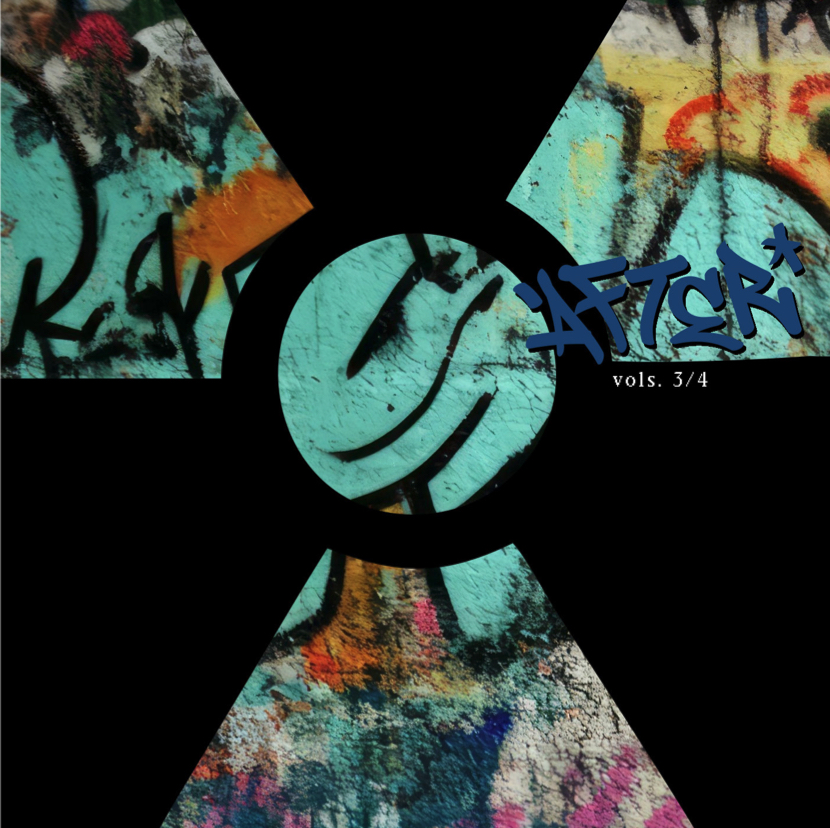
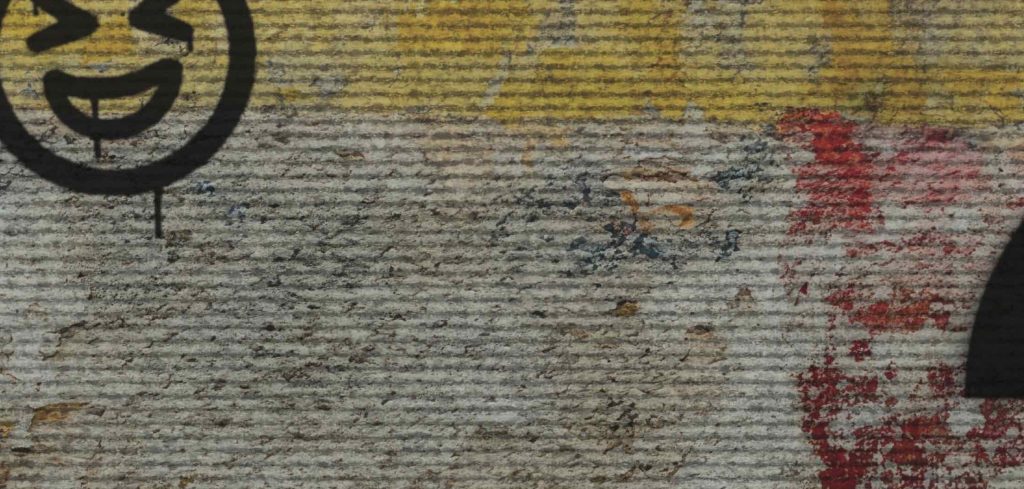
Video
MUSLAB -AFTER- vols 3/4
MUSLAB -AFTER-
The Phonographic production MUSLAB -AFTER-, is a selection of sound and audiovisual pieces from the MUSLAB International Electroacoustic Music Exhibition. MUSLAB aims to bring together and disseminate the creation and sound exploration of artists from different countries around the world, promote the creative process and contemporary artistic communication, to bring new audiences closer to contemporary sound creation, and create an international community network through the development of different cultural activities, training in new technologies and sound art concerts.
MUSLAB -AFTER- is an exhibition that brings together works by artists and researchers from different countries who develop sound and visual pieces on visions of the future of the global planetary scenario. Art as an oracle that contemplates the 22nd century and beyond from our contemporaneity. Compositions of electroacoustic music and video art that reflect on society, ecology and different aspects of planet Earth in the future. A proposal to develop new visions, build together a better world and promote more harmonious relationships in society and with nature.
